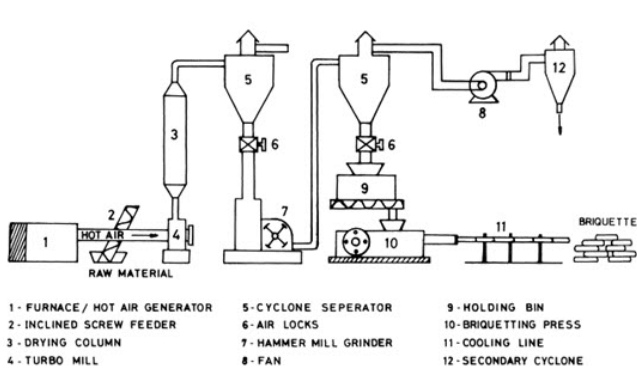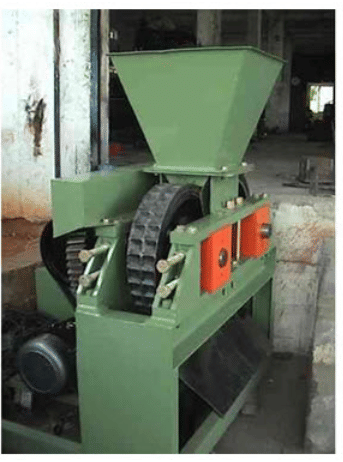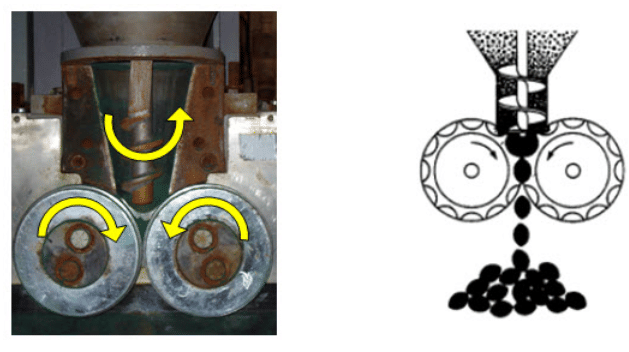Briquettes and cubes, Biomass Management for Fodder & Energy | Biomass Management for Fodder & Energy - Agricultural Engineering PDF Download
Introduction
Briquetting is the process of densification of biomass to produce homogeneous, uniformly sized solid pieces of high bulk density which can be conveniently used as a fuel. In this process, the raw material is pressed together at an elevated temperature and forced through an orifice. In a pure briquetting process, the pressure and temperature make the material bond with the help of its own lignin which acts as a binder. In some process utilizing a lower pressure or a lignin poor raw material, a separate binding material may be added.
4.2. Advantages of briquettes
better feed handling characteristics
higher calorific value
improved combustion characteristics
reduced particulate emissions
more uniform size
4.3. Binder less technologies
The compaction of loose biomass without any binding material is done using the technologies described below.
4.3.1. Die and punch technology
The piston presses are also known as ram and die technology. In this case the biomass is punched into a die by a reciprocating ram with a very high pressure thereby compressing the mass to obtain a briquette. The briquette produced is 60 mm in external diameter. This machine has a 700 kg/hr capacity and the power requirement is 25 kW. The ram moves approximately 270 times per minute in this process. Since the mechanical press is electric driven and not hydraulic driven, energy losses are reduced and throughput efficiency is increased.

The merits and demerits of piston press briquetting machine are:
- There is less relative motion between the ram and the biomass hence, the wear of the ram is considerably reduced.
- It is the most cost-effective technology currently offered by the Indian market.
- Some operational experience has now been gained using different types of biomass.
- The moisture content of the raw material should be less than 12% for the best results.
- The quality of the briquettes goes down with an increase in production for the same
- power.
- Carbonisation of the outer layer is not possible. Briquettes are somewhat brittle.
4.3.2. Screw technology
In this process, the biomass is extruded continuously by one or more screws through a taper die which is heated externally to reduce the friction. Here also, due to the application of high pressures, the temperature rises fluidizing the lignin present in the biomass which acts as a binder. The outer surface of the briquettes obtained through this process is carbonized and has a hole in the centre which promotes better combustion. Standard size of the briquette is 60 mm diameter.
The main merits and demerits of this technology are:
- The output from the machine is continuous and not in strokes, and is also uniform in size.
- The bulk density is higher (1500 kg/m3 against 1200 kg/ m3 for the die & punch technology).
- The outer surface of the briquette is carbonized facilitating easy ignition and combustion and also provides an impervious layer for protection against moisture ingress.
- The central core of the briquette is hollow which provides a passage for supplying the air necessary for combustion.
- The machine runs very smoothly with no shock loads.
- The machine is very light due to the absence of reciprocating parts and flywheel.
- There is no alternate suction and pressurization of machine thereby reducing the possibility of dust collection in the machine.
- The power consumed by this equipment is very high.
- The wear rate of the screw is very high.
- There is a limitation on the raw material that can be compacted.
The three types of screw presses used for briquetting are:
(i) conical screw press
(ii) screw press with heated die and
(iii) twin screw press.
4.3.2.1. Conical Screw Press
The raw material is compressed by a conical screw. The screw forces the material into the compression chamber. A rotating die head extrudes the material through a perforated matrix to produce briquettes of diameter about 2.5 cm. A knife cuts the densified product to a specified length. The conical screw press can also be used to produce briquettes with diameters of about 10 cm by using a single-die matrix.
4.3.2.2. Screw Press with Heated Die
The material is forced by a screw, having no taper or a small taper, through a die heated, usually electrically, from outside. The die has a number of ridges which serve to prevent the densified material from rotating with the screw. The briquettes are 5-10 cm in diameter. The die temperature is normally maintained at about 300oC. The raw material gets heated up to about 200oC during the process, most of the heating being caused by friction. The briquettes often get partially pyrolyzed at the surface, which causes quite a lot of smoking during briquetting. The design of the screw results in the formation of a central circular hole in the briquette, which acts as an escape route for steam formed during briquetting.
4.3.2.3. Twin Screw Press
In a twin screw two adjacent gripping shafts fitted with screw parts with varying leads, rotate closely and opposed to each other in "8" shaped casings. These casings are constructed as pressure casing boxes with cooling or heating section, as well as partly open sections with steam exhausts. Due to high pressure and friction, the temperature of the raw material could rise up to 250oC. The steam produced during densification is extracted by steam removal units. The briquette is extruded axially. In this press raw material having a particle size 30-80 mm and moisture content up to 25% can be densified without pre-drying.
4.3.3. Comparison of a prison press and a screw extruder
| Piston press | Screw extruder |
Optimum moisture content of raw material | 10–15% | 8–9% |
Wear of contact parts | Low | High |
Output from the machine | In strokes | Continuous |
Power consumption | 50 kWh/ton | 60 kWh/ton |
Density of briquette | 1–1.2 gm/cm3 | 1–1.4 gm/cm3 |
Maintenance | High | Low |
Combustion performance of briquettes | Not so good | Very good |
Carbonization to charcoal | Not possible | Makes good charcoal |
Suitability in gasifiers | Not suitable | Suitable |
Homogeneity of briquettes | Non-homogeneous | Homogeneous |
4.3.4. Hydraulic press based technology
This process consists of first compacting the biomass in the vertical direction and then again in the horizontal direction. The standard briquette weight is 5 kg and its dimensions and 450 mm x 160 mm x 80 mm. The power required is 37 kW for 1800 kg/h of briquetting. This technology can accept raw material with moisture content up to 22%. The process of oil hydraulics allows a speed of 7 cycles/minute against 270 cycles/minute for the die and punch process. The slowness of operation helps to reduce the wear rate of the parts. Further, the relative movement of the material within the die is only for a limited length. The wear and tear of the machine will be lower than those currently available machines in the Indian market.
The merits/demerits of this technology are as follows:
This technology can be used to compress any type of agro waste.
Raw material with moisture content up to 22% can be briquetted.
The power consumption is less compared to existing contemporary technologies.
The output of the machine is uniform.
The wear and tear of equipment will be less.
The cost of the machine is high.
The operational results are yet to be made available for Indian raw material.

4.3.5. Roller Press
Densification of biomass using a roller press works on the principle of pressure and agglomeration, where pressure is applied between two counter rotating rollers. The granular biomass, when forced through the gap between the two rollers, rotates with the rolls and is pressed in small dies or pockets. The rotation of the rollers causes the feed to be drawn in from one side and ejected from the other in the densified form. The final shape of the densified biomass depends on the type of die used. Design parameters, which play a major role on the quality of the biomass, are the diameter of the rollers, minimum gap size, roll force and shape of the die.

4.4. Cubes
The cubes can be made in a variety of densities and are extremely durable, stable and highly resistant to disintegration or breakage under normal conditions. Once in cube form, the densified organic material can be rapidly loaded with bulk loading and handling equipment for eventual storage, transport and consumption. Cubes might be suitable for use as industrial fuels.
The cuber die ring and press roller are similar to the die ring of a pelleter. An auger moves the chopped biomass uniformly toward the openings in the die ring. As the material leaves the auger flight, the heavy press wheel forces the feed through the die openings in the ring. The pressures in a cuber range from 24 to 34 MPa. The natural binders in chopped biomass, the high pressure of the press wheel, and heat generated by forcing biomass through dies help bond the cubes. An adjustable deflector around the outside of the die ring breaks the cubes in lengths of 50 to 75 mm. Cubing operators often find it necessary to add a binder to increase cube durability.
4.5. Binders used in biomass densification
Binders improve the cohesive characteristic of biomass by forming a gel with water, helping produce a more durable product. Binders also help reduce the wear on production equipment and increase the abrasion resistance of the fuel. In general, binders are allowed in a fuel feedstock but need to be specified as part of the final product. The most commonly used binders in pellet making are lignosulphonates (Wafolin), or sulfonate salts made from the lignin in pulp mill liquors. Lignosulfonates, considered the most effective binders, are used in animal feeds. The general quantity to include for effective binding ranges from 1–3%. Bentonite, or colloidal clay, is commonly used as a binder in feed pelleting and is made up of aluminum silicate composed of montmorillonite. As mentioned previously, proteins are natural binders that are activated through interactions with other biomass compositions, such as lipids and starches, and the heat produced in the dies. Some agricultural biomass, like alfalfa, has high protein content and can be used as a binder to improve the durability of pellets made from lower lignin content biomass materials.
4.6. Densification System Variables
Controlling the densification system variables is key for achieving the desired densified biomass quality. Specifically, the quality of the densified product can be managed by controlling conditions such the manufacturing process, changes in formulation, and the use of additives. In addition, process variables such as die thickness, die temperature, pressure, retention time, roller die ring gap, steam conditioning and feed rate affect the quality of densified biomass like density and durability. Feedstock variables (moisture content and particle size and shape) and feedstock composition (protein, fat, cellulose, hemicelluloses and lignin) also impact the quality of the densified biomass.
4.6.1. Moisture content
Moisture content plays an important role on pellet formation. Moisture in the biomass facilitates starch gelatinization, protein unfolding, and fiber solubilization processes during densification. Steam-treated biomass is superior to raw biomass because the additional heat modifies the physiochemical properties to the extent that binding between particles is enhanced, resulting in improved densification quality The effect of biomass moisture content on densification can be three-fold: (i) lowers the glass transition temperature; (ii) promotes solid bridge formation; and (iii) increases the contact area of particles by van der Waal’s forces.
4.6.2. Particle size, shape, and distribution
In general, the density and durability of pellets is inversely proportional to the particle size because smaller particles have greater surface area during densification. However, very small particles can lead to jamming of pellet mills and affect production capacity. In the case of briquette presses, bigger particles sizes (>6 mm) are desirable, leading to better interlocking of the particles and increasing the durability.
4.6.3. Feedstock composition
Feedstock composition contributes significantly to the quality of densified materials. Raw biomass has both low molecular weight and macromolecular compositions. Low molecular weight substances include organic and inorganic matter, while macromolecular substances include cellulose, hemi-cellulose, and lignin Wood is shown to have higher lignin content than other biomass materials, and straws are shown to have a certain percentage of protein content, both of which can promote binding.
Starch is a D-glucose polymer with branched (amylopectin) or unbranched (amylose) chains. Its behavior is mainly controlled by the gelatinization it undergoes at high processing temperatures. Starch granules at high temperatures and moistures influence the binding properties of many foods and feeds. Gelatinization of starch is an irreversible process and influenced by densification process variables like heat, water, shear, and residence time. During pelletization, starch not only acts as a binder but also as a lubricating agent, helping to ease the flow of materials through the die.
Protein that is heated during the densification process undergoes denaturization, leading to the formation of new bonds and structures with other available proteins, lipids, and starches,helping to improve the binding capacity
Fat content in biomass acts as a lubricant during pelletization, increasing throughput, and reducing pelleting pressure. However, higher fat content can hinder binding.
Cellulose is an organic, polysaccharide compound forms crystalline microfibrils that are surrounded by amorphous cellulose inside plant cells. Semi-crystalline structure and highly hydrogen bonded cellulose itself is not a suitable adhesive, but this limitation can be overcome by heat treatment in the drying range, making the cellulose molecule more flexible.
Lignin helps in building solid bridges at elevated temperatures and plays a signifi cant role in biomass densification. It is, in general, believed that highly lignified wood is more durable and therefore a good raw material for many applications. It is also an excellent fuel, because lignin yields more energy when burned than cellulose. The presence of lignin in plant materials allows pelletization without adding binders.
Hemicellulose is any of several heteropolymers (matrix polysaccharides), such as arabinoxylans, present along with cellulose in almost all plant cell walls. Some researchers believe that natural bonding may occur due to the adhesive products produced by degradation of hemicelluloses
FAQs on Briquettes and cubes, Biomass Management for Fodder & Energy - Biomass Management for Fodder & Energy - Agricultural Engineering
| 1. What are briquettes and cubes used for in biomass management? |  |
| 2. How does biomass management benefit both fodder and energy production? |  |
| 3. Can briquettes and cubes be used interchangeably in biomass management? |  |
| 4. What are the key considerations for selecting biomass for briquettes and cubes? |  |
| 5. Are there any environmental benefits associated with biomass management for fodder and energy production? |  |




















